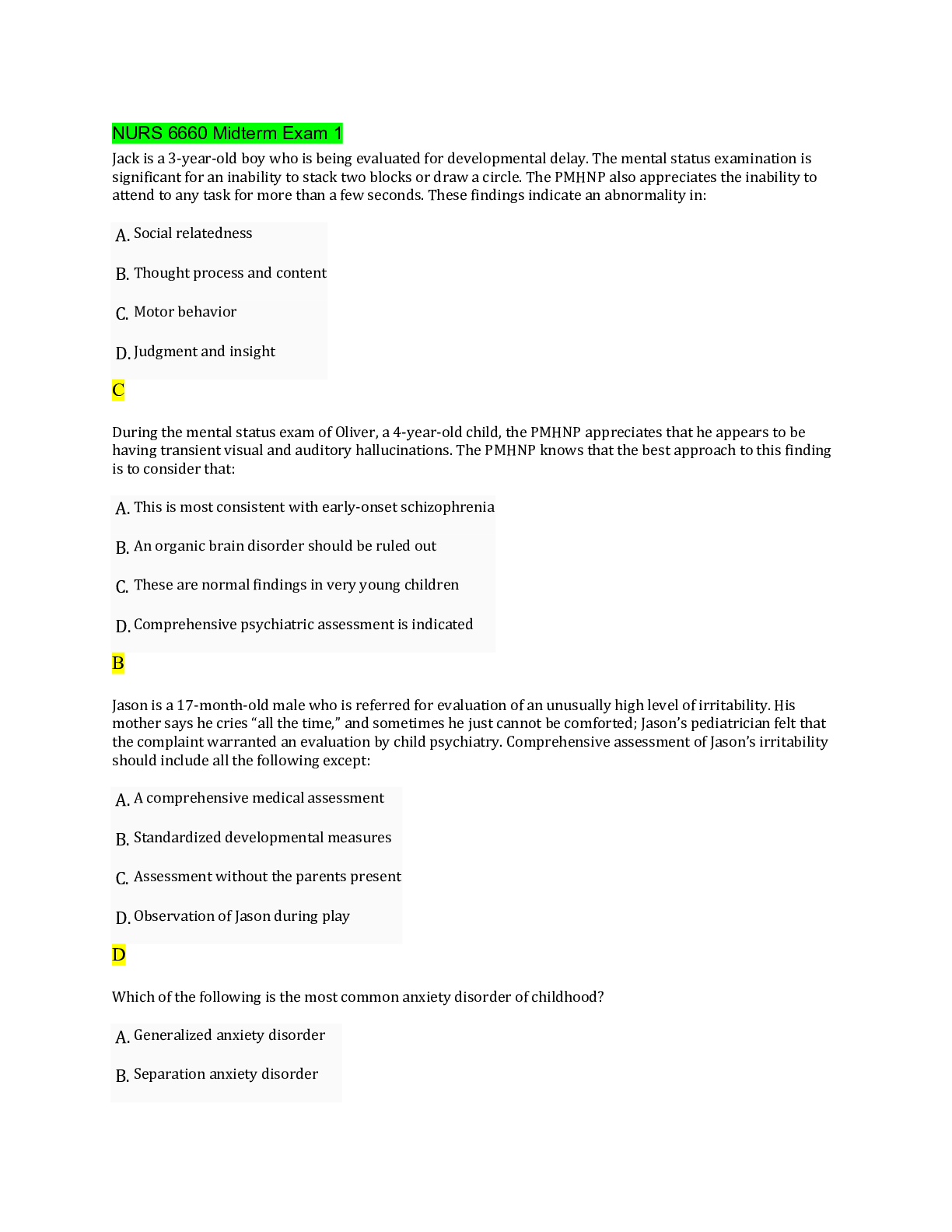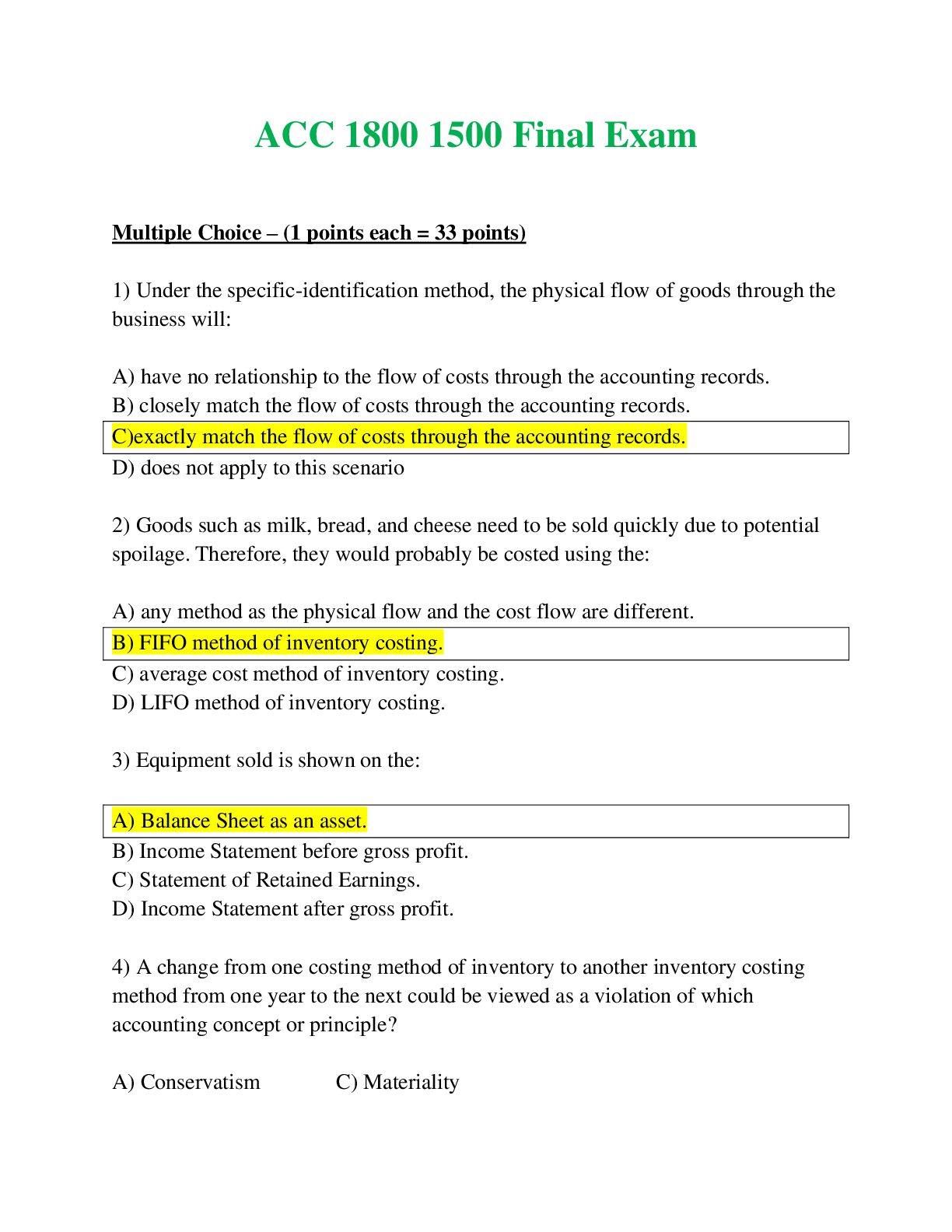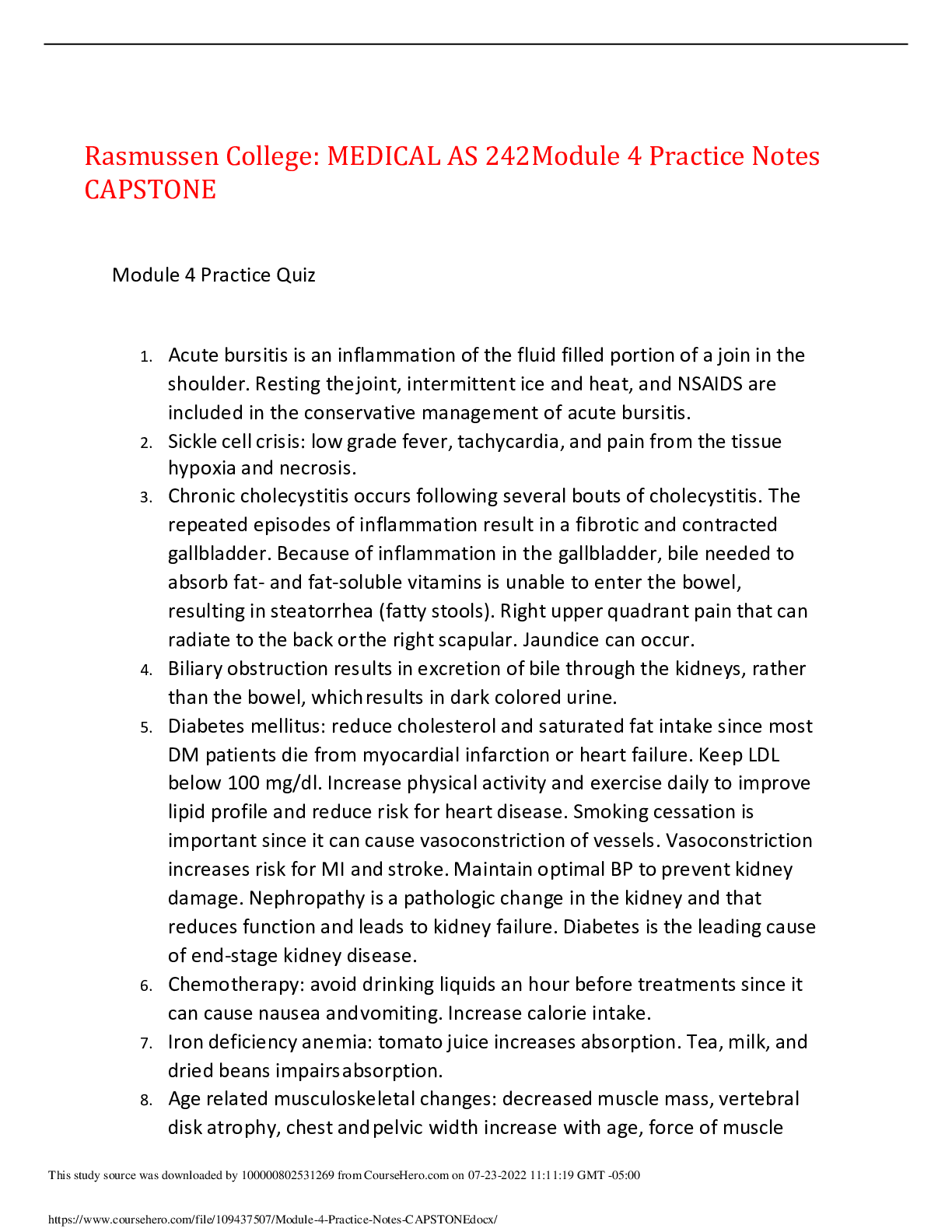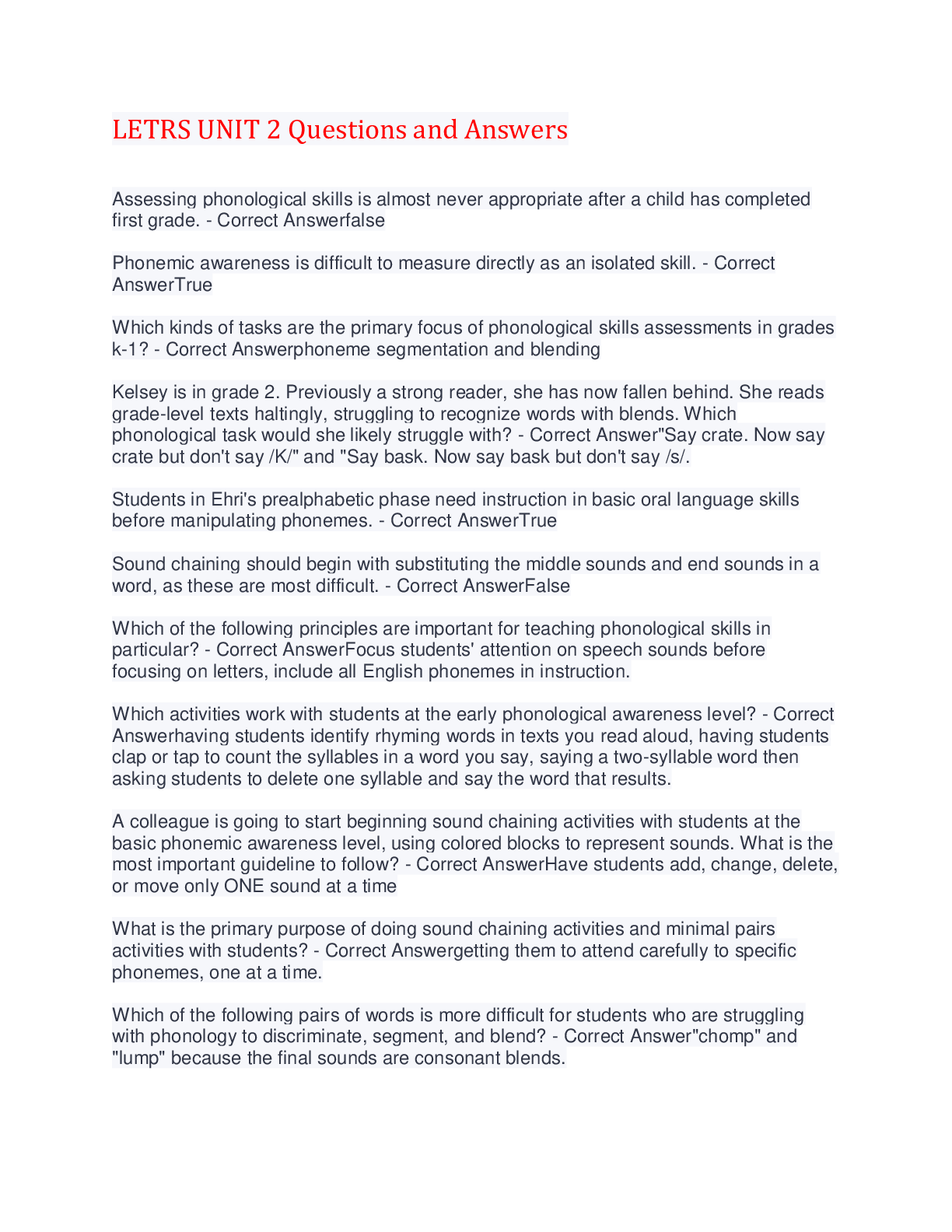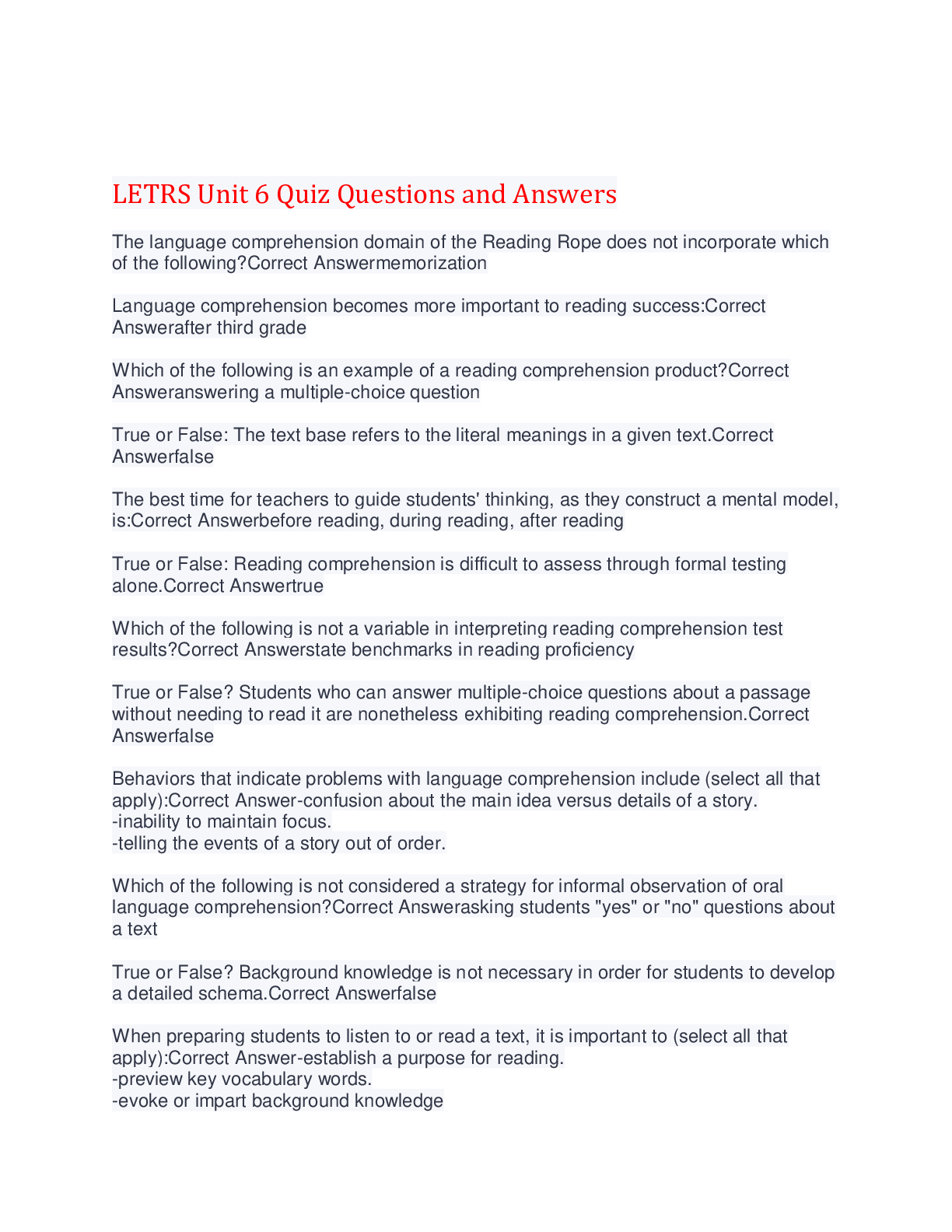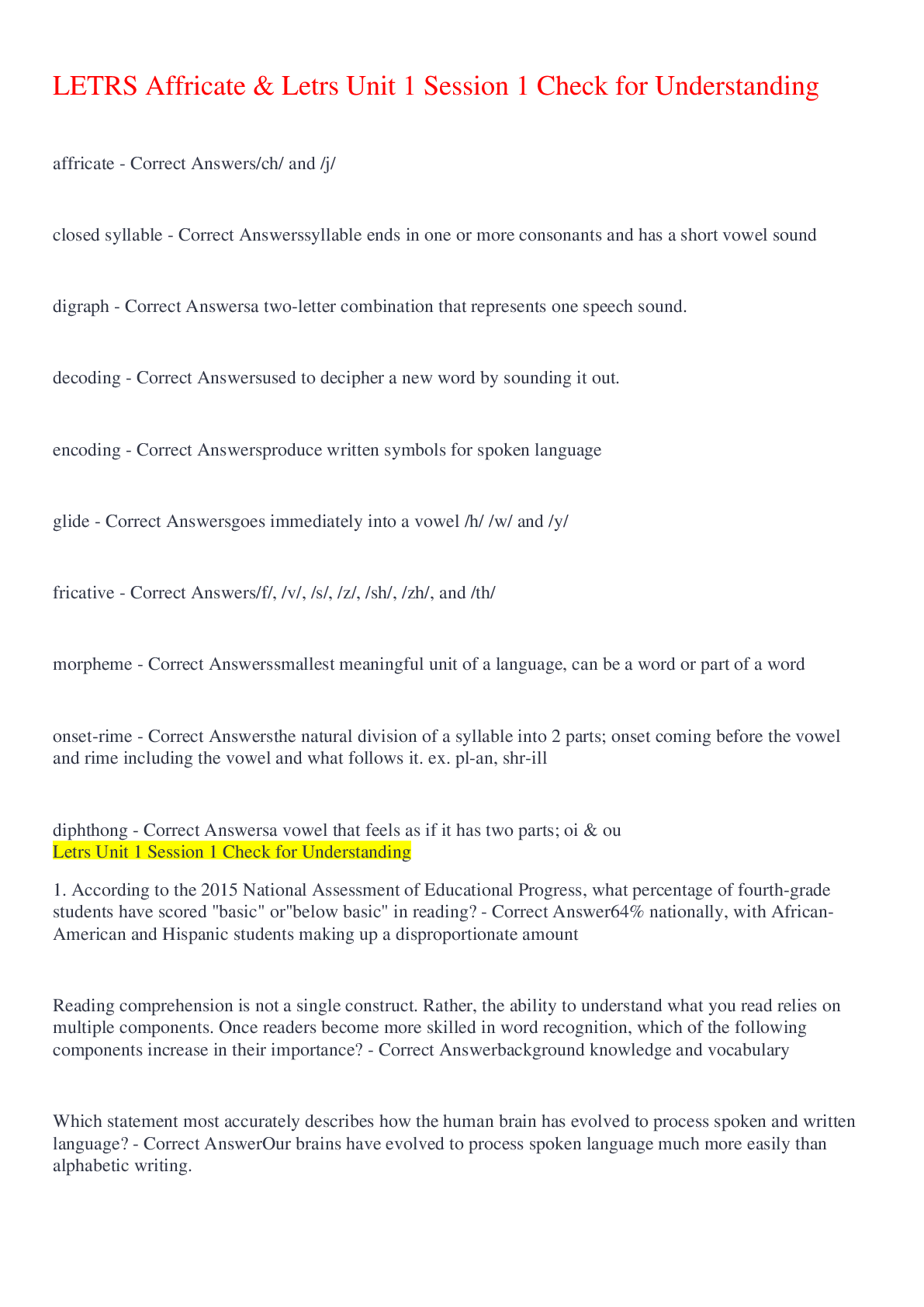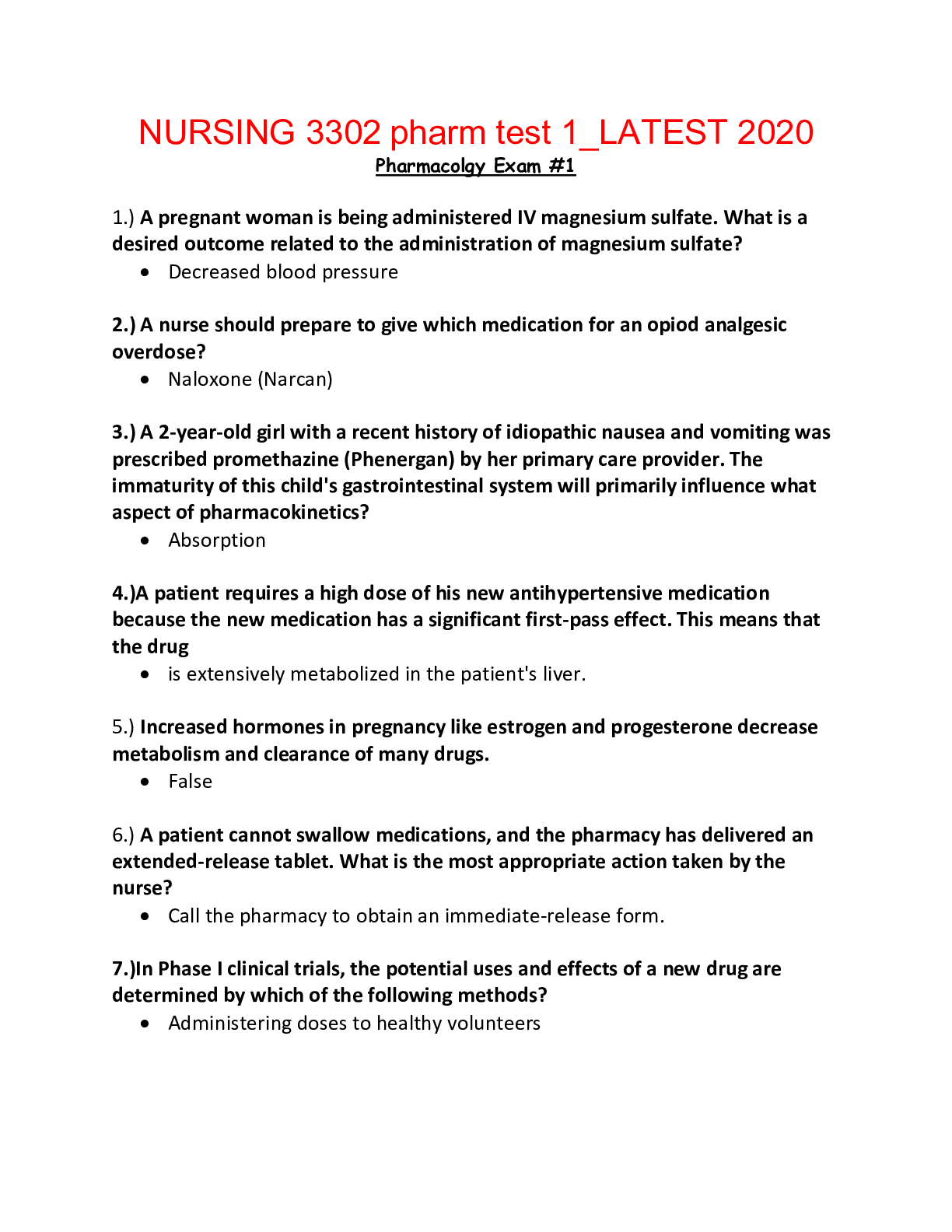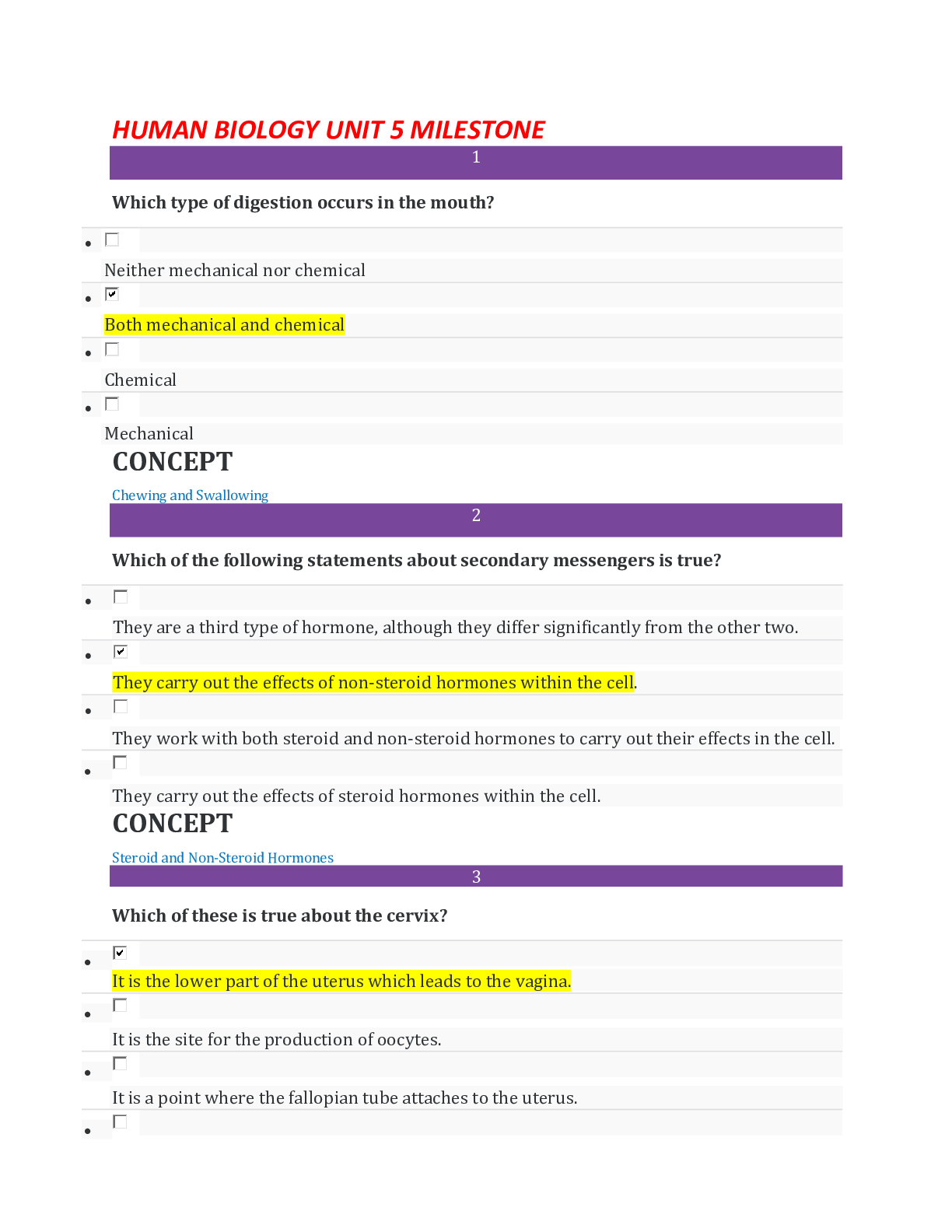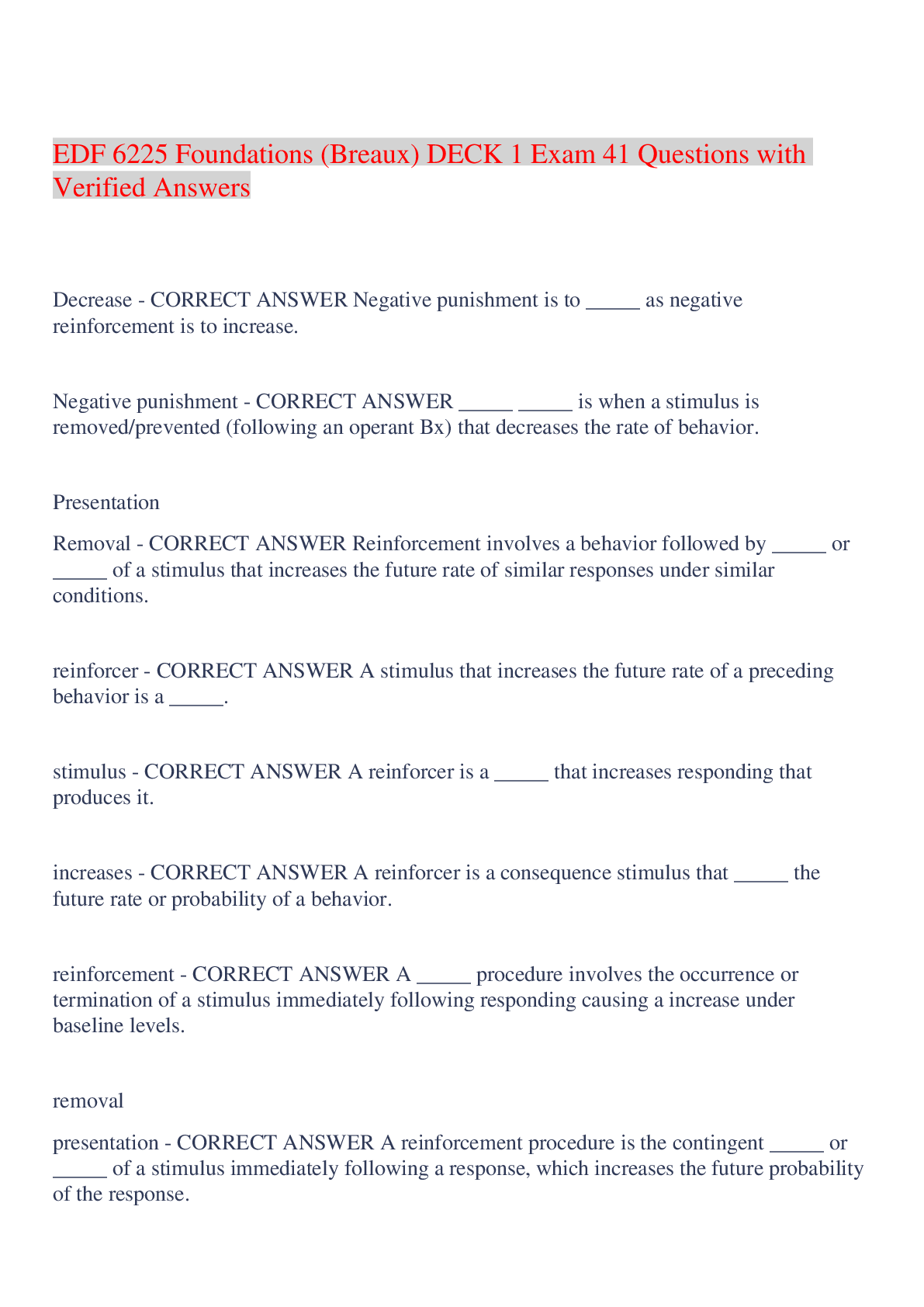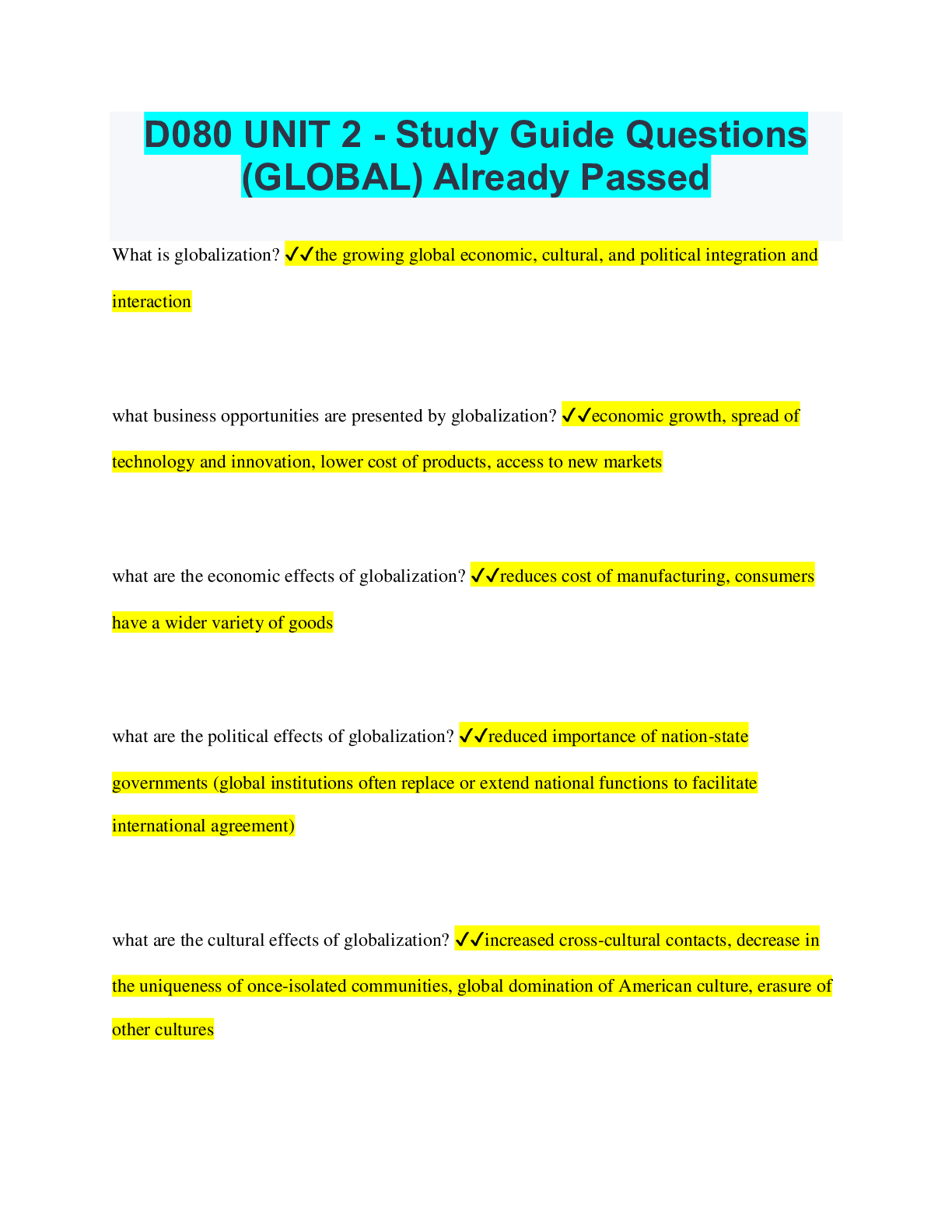PNUR 104 Wk 1 Day 2 - Study Guide Fall 2022/2023,100% CORRECT
Document Content and Description Below
PNUR 104 Wk 1 Day 2 - Study Guide Fall 2022/2023 Please refer to PNUR104 Course Outline to guide readings and weekly learning outcomes. Nursing Metaparadigm Concept: HEALTH Priority!!! a... ) List the Social Determinants of Health in the chart below a. (Life threatening, Health threatening, and developmental) In the relation to the ABCDE’s i. Airway, Breathing, Circulation, Disability, Exposure b) Provide examples of how the determinant could have a positive or negative effect on health. Circle the determinants that you see affecting your health positively. c) **Be prepared to list/name the various health determinants and discuss some examples in class. Health Determinant Example of Positive Effect Example of Negative Effect 1. Income and Social Status People with lower incomes are more likely to have chronic health problems, particularly cardiovascular disease and type 2 diabetes 2. Social Support Networks Four of five Canadians reported that they had someone to confide in, whom they could count on in a crisis or for advice, and who made them feel loved and cared for. Nevertheless, men, lone- parent families, and lower- income Canadians generally reported less support than did their respective counterparts. 3. Education and Literacy People with higher education levels tend to smoke less, be more physically active, and have access to healthier foods and physical environments For example, people with low literacy skills are more likely to be unemployed, receive income support, earn minimum wages in unskilled jobs, have higher stress levels, and make less use of preventive services 4. Employment and Working Conditions Healthy workplaces include job and employment security, safe physical conditions, reasonable work pace, low stress, opportunities for self-expression and individual development, participation, and work–life balance Unemployment is linked to material and social deprivation, adoption of health-threatening coping behaviours, psychological stress, and physical and mental health problems 5. Physical Environments Municipalities throughout Canada have incorporated smoking bans in public places (and, in several jurisdictions, smoking bans in private cars when children are present) to limit involuntary exposure to tobacco smoke (second- hand smoke). In March 2010, over 800,000 Canadians were assisted by food banks, a 9% increase over 2009 and the highest level on record. Over half (51%) of these users were social assistance recipients, and 51% were families with children, half of whom were two-parent families 6. Biological and Genetic Endowment Indeed, 70% of older people in Canada report good overall health, including good functional health and independence in activities of daily living Many older people develop chronic diseases, although disability can be reduced with healthy aging 7. Individual Health Practices and Coping Skills Developing and maintaining health- enhancing behaviours requires not only health education but also social policies related to income security, product marketing, and supportive environments that make healthy choices the “easy” choices. For example, considerable evidence indicates that low- income women use smoking as a coping strategy 8. Healthy Child Development (Early Life) High-quality programs promote cognitive development and social competence and support parents in education and employment. Canada has acknowledged the importance of early childhood intervention through its Early Childhood Development Initiative High-quality programs promote cognitive development and social competence and support parents in education and employment. Canada has acknowledged the importance of early childhood intervention through its Early Childhood Development Initiative 9. Health Services (Health Care Services) Considerable monies have been invested in initiatives that incorporate principles of primary health care; Medicare does not cover drug costs or dental care, and home care coverage varies across provinces contributing to inequitable access. 10. Gender men are more likely than women to experience extreme forms of social exclusion and to die prematurely, largely as a result of heart disease, unintentional fatal injuries, cancer, and suicide. Women, however, are more likely to suffer from depression, stress (often resulting from efforts to manage both paid and family work), chronic conditions such as arthritis and allergies, and injuries and death from family violence 11. Culture For example, Indigenous youth living on reserve who are between the ages of 10 and 29 years are five to six times more likely to die by suicide than are non-Indigenous youth; 40% of deaths among Inuit youth are a result of suicide, compared to 8% in the rest of the population 12. Social Environments A strong public health drive to address the inequities in health and social outcomes experienced by LGBTQ youth has led to some school boards in Canada establishing gay-straight alliances in schools to provide community and peer support to LGBTQ youth Canadian youth who identify as lesbian, gay, bisexual, transgender, or queer (LGBTQ) experience disparities in their health and social outcomes compared to outcomes in their heterosexual peers Homework: Read the 6 Case Studies posted separately on e-centennial. Identify the Health Determinants relevant for the stories in the Case Studies. Case #1 A 35-year-old woman is three months pregnant and signs up to attend the prenatal classes at the hospital. During the visit, she tells the nurse that she is afraid to go back home because her husband is very abusive. - Health Services (Health Care Services) - Social Environments - Social Support Networks Case #2 A 40-year-old man, who lives on the streets, is taken to the shelter during a “cold alert.” - Social Environments - Physical Environments - Income and Social Status - Social Support Networks Case #3 An elderly woman lives alone since her husband died two years ago. She is becoming more frail and has difficulty getting her house work done and cooking for herself. She usually has tea & toast for breakfast. Lunch is provided by the Meals on Wheels Program. She keeps half of the meal for dinner. - Social Support network - Health Services (Health Care Services) - Biological and Genetic Endowment - Physical Environments Case #4 A single mom takes her 3-year-old child to the hospital emergency department because of nausea and vomiting. The nurse determines that the child is malnourished. The nurse attempted to provide health teaching to the child’s mother but she started crying and stated, “I am so worried about my job, I just started two weeks ago.” - Healthy child development ( the child is the patient in this case) Case #5 A female client is admitted to the hospital with a diagnosis of depression that has been ongoing for two months since her employer cut her working hours. - Income and Social Status - Social Support Networks - Employment and Working Conditions Case #6 A 16-year-old client who recently migrated to Canada from Turkey. The client tells the nurse that he is really missing his country of origin, “everything and everyone is so different”. He was not a smoker but now he smokes one pack of cigarettes per day as he is having difficulty concentrating at high school. He does not like the structure of the classes so sometimes he skips classes. - Physical Environments - Individual Health Practices and Coping Skills - Culture Define the following key terms: Health Promotion: enabling people to increase control over, and to improve their health Disease Prevention: action to avoid or forestall illness/disease What is the difference between health promotion and disease prevention? (client specific) initial conceptualization of levels of prevention considered health promotion as one aspect of primary prevention and not necessarily disease specific. In contrast, the Ottawa Charter views health promotion as the overarching concept, defined as “the process of enabling people to increase control over, and improve, their health” (WHO, 1986). The following, more comprehensive, definition was offered by Nutbeam (1998): What are the 3 Levels of disease prevention? Define each and give an example Primary Prevention - activities protect against a disease before signs and symptoms occur Examples: - immunization (to prevent infectious diseases) and reduction of risk factors (such as inactivity, smoking, and exposure to air pollution). Secondary Prevention promote early detection of disease once pathogenesis has occurred, so that prompt treatment can be initiated to halt disease and limit disability. Examples: - preventive screening for cancer (e.g., Pap test, testicular self-examination), blood pressure screening to detect hypertension, and blood glucose screening to detect diabetes. Tertiary Prevention initiated in the convalescence stage of disease and are directed toward minimizing residual disability and helping people to live productively with limitations. Examples: - a cardiac rehabilitation program after a myocardial infarction. Levels of Prevention - Cross-Match Exercise Level of Care Indicate beside each example which level of care (1, 2, or 3) Primary (1) Secondary (2) Tertiary (3) 3 Stroke Rehab 2 Blood Tests 1 Immunizations 2 Diabetic Diet Teaching 2 Breast Self-Exam 3 Physiotherapy 3 Breast Feeding Clinic 1 Flu Shot 1 Sex Education Classes 2 Chest X-Ray 3 Marriage Counseling 2 Biopsy What are the five (5) strategies identified by the Ottawa Charter to improve health promotion? List the five strategies and provide a brief description in your own words. 1. Build Healthy Public Policy. a. Advocating healthy public policy means focusing on policies that create healthy living conditions. Because the determinants of health are broad, healthy public policy necessarily extends beyond traditional health agencies and government health departments to other sectors such as agriculture, education, transportation, labour, social services, energy, and housing. Therefore, policymakers in all government sectors and organizations should ensure that their policies have positive health consequences. 2. Create Supportive Environments a. The Ottawa Charter (WHO, 1986) states that “the overall guiding principle … is the need to encourage reciprocal maintenance, to take care of each other, our communities and our natural environment” (p. 2). This strategy helps ensure that physical environments are healthy and safe and that living and working conditions are stimulating and satisfying. Creating supportive environments also means protecting the natural environment and conserving natural resources 3. Strengthen Community Action a. communities identify issues and work together to make changes that will enhance health. In a community development approach, health providers help community groups identify important issues and organize and implement plans and strategies to resolve these issues, often partnering with other community organizations 4. Develop Personal Skills a. This strategy, which is probably most familiar to nurses, helps clients develop personal skills, enhance coping strategies, and gain control over their health and environments so that they can make healthy lifestyle choices. Personal skills development includes health education, but it also emphasizes adequate support and resources. 5. Reorient Health Services a. Health system reform has two objectives: to shift emphasis from treating disease to improving health, and to make the health care system more efficient and effective (CPHA, 1996). A proactive approach to health requires improved access to primary health care services, increased community development, improved community-based care services, increased family-based care, and public participation. Health care settings: What are the 3 types of health care delivery settings in Canada? Provide examples of each delivery setting. 1. Institutional Sector Example Institutional agencies, including hospitals, long-term care facilities, psychiatric facilities, and rehabilitation centres, offer health care services to inpatients (who stay at an institution for diagnosis, treatment, or rehabilitation). Most offer services to outpatients (who visit an institution for select services). 2. Community Sector Example Community services are directed at primary and secondary care, described later in this chapter, and should be accessible to patients in locations where they live, work, play, and engage. 3. Private Sector Example Therapists, What are the five (5) LEVELS OF HEALTH CARE? List the 5 levels of care and provide an example of each. 1. Health Promotion Example building healthy public policy, creating supportive environments, strengthening community action, developing personal skills, and reorienting health care services. Furthermore, the foundation of health promotion consists of “the fundamental conditions and resources for health, [which] are peace, shelter, education, food, income, a stable ecosystem, sustainable resources, social justice, and equity” 2. Disease and Injury Prevention Example Prevention strategies include clinical actions (immunizing), behavioural aspects (support groups), and environmental actions (climate control activism) 3. Diagnosis and Treatment Example Diagnosis and treatment focus on recognizing and managing individual patients' existing health problems at three sublevels: primary, secondary, and tertiary. 4. Rehabilitation Example Rehabilitation occurs after a physical or mental health illness, injury, or chemical addiction or is related to chronic illness, disability, frailty, and aging. Ideally, rehabilitation begins the moment a patient enters a health care setting for treatment as part of an interdisciplinary effort (i.e., therapists [physical, occupational, respiratory], nurses). 5. Supportive Care Example Supportive care consists of health, personal, and social services provided over a prolonged period to people who are disabled, who do not function independently, or who have a terminal disease. What are the four (4) Pillars of Primary Health Care (PHC) described in the PHC models? 1. Teams 2. Access 3. Information 4. Healthy Living What are the concerns and barriers to PHC in Canada? In what ways do you see yourself contributing in a positive way to help Canadian PHC overcome these concerns? (THINK ABOUT: as you are coming into the system as a new practical nursing student) Individual-level barriers, such as lack of role clarity and trust, are often attributed to limited knowledge of other team members' knowledge, skills, and scopes of practice. Practice-level barriers, according to the CASHC (2012), are closely linked to hierarchical issues at the level of governance and leadership, as well as to strategic team attributes and skills (i.e., skill mix, communications). Lack of interprofessional education, appropriate funding, and monitoring and evaluation are system-level barriers. Consider the challenges in Global Health described in your textbook. How do these connect to the Social Determinants of Health? Nursing Metaparadigm Concept: PERSON (and FAMILY) Define “person” according to the Nursing Metaparadigm. - By the 1960s, professional leaders recognized that nurses did much more than simply care for hospitalized patients.??? Why is the term “client” sometimes used? What is the basic difference between the terms “patient” and “client” (from a health perspective)? - The term signified a range of health states, including both sickness and wellness, and an explicitly interactive relationship between the nurse and the persons to whom care was directed. Who may be the “client” in nursing? - the persons to whom care was directed Why is it important to include the family in the delivery of care? - Nurses need to understand clients as individuals. How can each individual client can be unique/different that would be relevant for nurses to consider? (This is a very broad question and could be endless – try to think of 10! - Gender - Language barrier - Age - Biological factors - Income situation - Coping mechanisms - Addictions - Mental health problems - Education and literacy - Social support - - Define the following terms: Family: defined as a set of relationships that each patient identifies as a network of individuals who influence each other's lives, regardless of whether actual biological or legal ties exist. In other words, each person has an individual definition of who or what constitutes family Family Nursing: based on the assumption that every person, regardless of age, is a member of some type of family form and carries family experiences that have profound influences on their lives and approaches to health care Family Forms/Types: patterns of people considered by family members to be included in the family (Box 19-1). Although all families have some common characteristics, each family form has unique challenges and strengths. It is important for nurses to maintain an open mind about what constitutes a family so that potential resources and concerns are not overlooked. What are the “family forms” described in the textbook? THINK ABOUT: Which family form(s) describes your family situation? Blended Family - Formed when both parents bring children from previous relationships into a new, joint living situation or when children from the current union and children from previous unions are living together Extended Family - Includes the nuclear family and other relatives (perhaps grandparents, aunts, uncles, cousins) Lone-Parent Family - Consists of one parent and one or more children. The lone-parent family is formed when one parent leaves the nuclear family because of death, divorce, or desertion or when a single person decides to have or adopt a child. Step-Family - Formed when at least one child in a household is from a previous relationship of one of the parents Traditional Nuclear Family - Consists of a mother and father (married or common-law) and their children Complete Types of Family Cross-Match Exercise Use information from your readings to help you figure out the form/type of family. What additional questions could be asked to get more specific information about these families? Please note that there may be more than one answer. Form/Type of Family Family Description – which type(s) are described (B, E, LP, S and/or TN) Blended (B) TN Client A lives with a partner and their three children. Extended (E) S Client B lives with their partner along with their partner’s 2 children and their own child from previous marriage. Lone-Parent (LP) Step (S) LP Client C is widowed (spouse has died). They are living with their 2 children and working fulltime. Traditional Nuclear (TN) E Client D and Client E are married with a son and a daughter. Client D’s parents are living with them. B Client F is living with Client G and Client G’s two children. What are the factors influencing the health of the individual and the family? - biology, social status, economic resources, politics, violence, and geographic and environmental contexts. Identify and describe the attributes of a Healthy Family. - This type of family has a flexible structure for task performances and is receptive to help from outside the family system while maintaining a sense of strength and stability. - An effective family exerts influence on the immediate environment of home, neighbourhood, and school, whereas a crisis-prone family may lack, or believe it lacks, control over these environments. What does the term hardiness mean? - the internal strengths and durability of the family unit and is characterized by a sense of control over the outcome of life, perceiving change as beneficial and growth producing, and having active rather than passive approaches to stressful events What does the term resiliency mean? - the ability to cope with expected and unexpected stressors: role changes, developmental milestones, and crises. What are the factors that influence family resiliency? Circle the factors that most relate to your family experience - Factors influencing family resiliency include positive outlook; spirituality; flexibility; cohesiveness; clear communication; financial management; shared family involvement in recreation, routines, and rituals; and support networks. What would be the role of family in health care? - How does culture influence the values, beliefs and health practices of individuals and families? - Family Assessment: Use the Calgary Family Assessment Model (CFAM) to determine what information should be assessed under the following categories. • Structural assessment o Internal structure: the people who are included in the family and how they are relationally connected to one another o External structure: the relationships the family shares with people and institutions outside the family unit o Context: the whole situation or background relevant to the family • Developmental assessment o Family development is more than the concurrent development of children and adults. It is the interaction between an individual's development and the phase of the family developmental life cycle that can be significant for family functioning. Therefore, in addition to understanding family structure, nurses need to understand the developmental life cycle of each family. • Functional assessment o A functional assessment focuses on how family members interact and behave toward each other. Nurses assess family functioning by closely observing the interactions of family members in two subcategories: instrumental and expressive functioning. How would you use the Calgary Family Assessment Model to identify family needs, strengths and challenges? Try to complete an assessment of your family using the CFAM ********* Click the below link to gain access to a video that will provide additional information about family and family assessment. (Westera, D. (July 5, 2010) Family assessment in community health nursing.) https://www.youtube.com/watch?v=p77hAbldXvU Give examples for each of the following: • Family Structure (include a genogram) • Family Roles & Functions • Physical Health Status of each member – health care practices • Interaction Patterns – communication (openness), methods of expressing emotions • Family Values – cultural, religion, leisure time, education, health promotion • Coping Resources – emotional support, availability, handling stress, finances What is a Genogram? - a sketch of the family structure and relevant information about family members - Review the basic sample/example of a genogram in the textbook and know how the below information would be represented on a genogram. **practice making genograms using case studies on eCentennial • male or female, ages • married, common law relationship, separated, divorced. • children, parents • death • medical information, occupation or schooling, religion, ethnicity Can you identify any limitations with the genogram example provided in your textbook? (what would you suggest to the textbook authors to improve in this content?) ************** Illness Narratives What is meant by the phrase “illness narrative”? - the person's story of how the illness affects his or her whole being, including emotional, intellectual, social, and spiritual dimensions Why is the meaning of illness or the “lived experience” of illness important to nursing care? - Communicating what it is like to live with individual, separate experiences, particularly the experience of illness, is a powerful human need (Wright, 2005). Frequently, nurses believe that listening entails an obligation to “fix” whatever concerns or problems are raised. However, showing compassion through deep listening and offering commendations are usually more therapeutic or helpful than offering solutions to problems Explain what the quote means “involvement of family members, helps the nurse understand the meaning of illness to the patient and the family”? What questions would you ask to get this understanding? - Careful relational engagement, eliciting the illness narrative, asking circular questions, offering commendations, as well as externalizing inner dialogue are particularly helpful interventions that may lessen suffering. The exploration of alternative illness beliefs within the therapeutic conversation opens possibilities for family healing and new ways of living with illness. - • When a family member shares his or her illness narrative with a nurse, other family members are able to adopt a listening, reflective stance, enabling the family to listen and understand each other's experiences differently. Effective Family Nursing Practices What are the relational nursing practices that promote family health and functioning? List these and briefly provide an example - Encouraging Family Support o encouraging and assisting family members to listen to each other's concerns and feelings. - Supporting Family Caregivers o Nurses can play a key role in helping family members develop better communication and problem-solving skills needed for caregiving. - Encouraging Respite o Nurses should encourage respite for caregivers, who may feel guilty about or not even recognize their need to withdraw, even temporarily, from caregiving tasks. - *********** In what ways does illness affect the Family/Significant Others? Discuss the impact on the following when a family member is experiencing illness: • Role changes, increased stress • Financial problems • Loneliness, change in social customs/values • Decreased length of hospital stays → shift in increased care by families Discover how to navigate the online resources: RNAO Best Practice Guidelines! *********** Person and Family Centered Care 1. Check out the website https://rnao.ca/bpg/guidelines 2. Search for the Best Practice Guideline: Person and Family Centered Care 3. Briefly, look for answers to the following questions: • How is the term “Person” used in this guideline? (p. 8) • What are the themes in Person and Family-Centred Care? (p. 21, 22) • What is described in the Common Themes of Patient Charter of rights and responsibilities? (briefly review - p. 96) ** Complete the Jane Case Study on eCentennial by identifying and discussing the impact of illness on Jane and her family While you are in the RNAO BPG Person and Family-centred Care, look at the model on page 21 (Healthcare partnerships). In what ways does this model reflect the concepts we are learning about in the Nursing Metaparadigm? (Do you see any key words or similarities?) Nursing Metaparadigm Concept: Environment Identify a) What could be included in a client`s internal surroundings? b) What could be included in a client`s external surroundings? How can access to home and community services influence the health of individuals and communities? *We will be looking more closely at how to navigate online resources for home and community care services. To become familiar with some of the information, please check-out these websites before coming to class: https://www.ontario.ca/page/home-community-care http://healthcareathome.ca/torontocentral/en Family Case Study Review Elsie & Bob and Theo & Maria case studies as posted separately on e-centennial a) Do a Genogram and complete a Family Assessment Guide. b) What are some strengths and challenges for these families? c) Identify selected community resources to assist the senior and/or their families with existing or potential health problems. [Show More]
Last updated: 2 years ago
Preview 1 out of 15 pages

Buy this document to get the full access instantly
Instant Download Access after purchase
Buy NowInstant download
We Accept:

Reviews( 0 )
$15.00
Can't find what you want? Try our AI powered Search
Document information
Connected school, study & course
About the document
Uploaded On
Mar 15, 2023
Number of pages
15
Written in
Additional information
This document has been written for:
Uploaded
Mar 15, 2023
Downloads
0
Views
42


